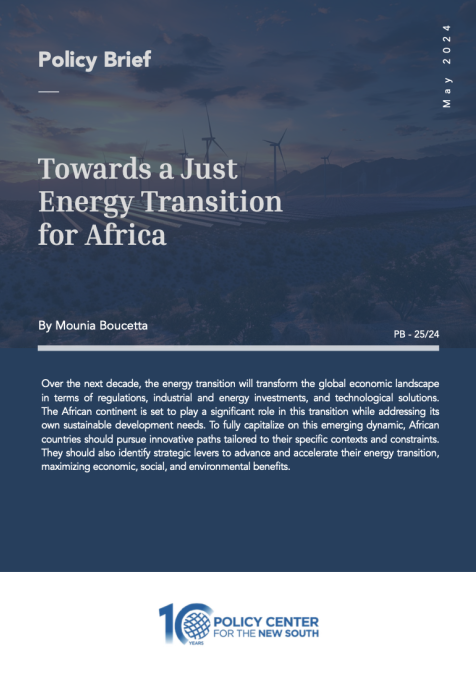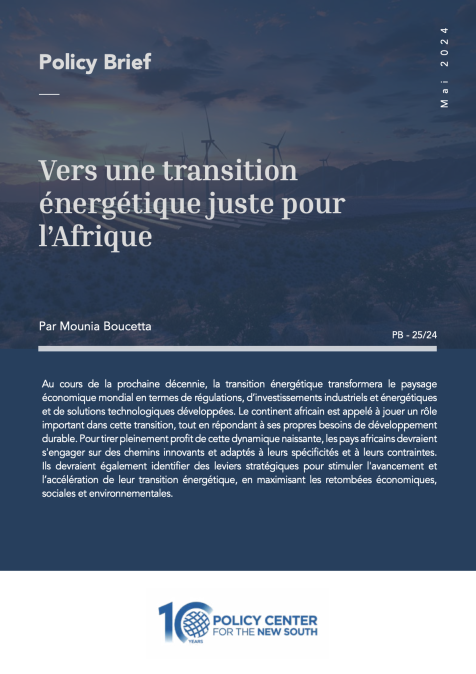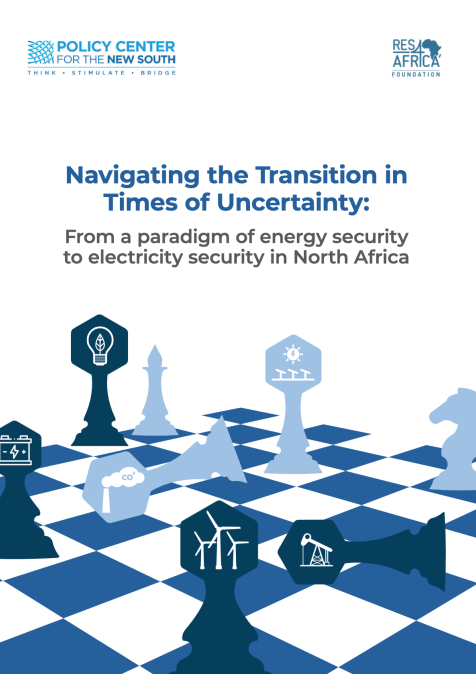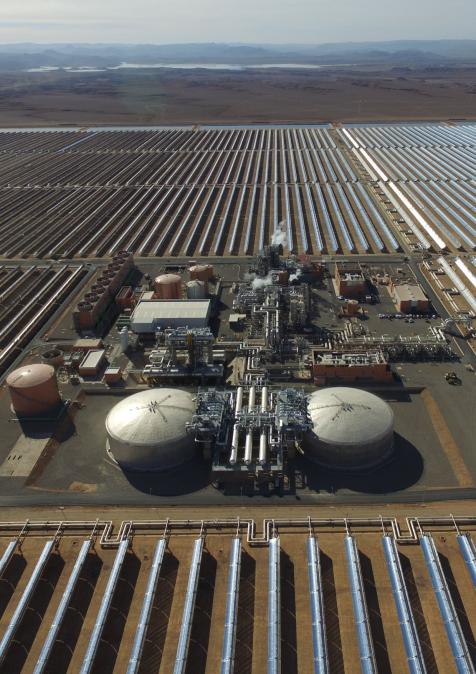Publications /
Policy Brief
Over the next decade, the energy transition will transform the global economic landscape in terms of regulations, industrial and energy investments, and technological solutions. The African continent is set to play a significant role in this transition while addressing its own sustainable development needs. To fully capitalize on this emerging dynamic, African countries should pursue innovative paths tailored to their specific contexts and constraints. They should also identify strategic levers to advance and accelerate their energy transition, maximizing economic, social, and environmental benefits.
Introduction
To address climate change, the energy transition is an essential transformative process aimed at reducing carbon emissions. This includes shifting from fossil fuels to renewable energy, enhancing energy efficiency, and reducing energy demand by altering consumption patterns.
According to the Intergovernmental Panel on Climate Change (IPCC), to have a chance of limiting global warming to 1.5 degrees Celsius, as set out in the Paris Agreement of 2015, countries must cut their emissions by 43% by the end of the decade compared to 2019 levels. Therefore, the transition process must be accelerated, and it is no longer an option but a necessity for both developed and developing nations.
Recent health and geopolitical crises have led to a rise in petroleum product prices, making renewable energy increasingly competitive. This situation is further bolstered by technological advancements in recent years. For instance, the Levelized Cost of Electricity (LCOE) for solar energy has been consistently decreasing, reaching levels comparable to fossil fuels and potentially becoming more competitive under certain conditions. The same trend is observed for wind energy. The decline in investment and operational costs for renewable energy production facilities explains the shift, since 2018, from additional thermal energy capacities to investments in wind and solar units.
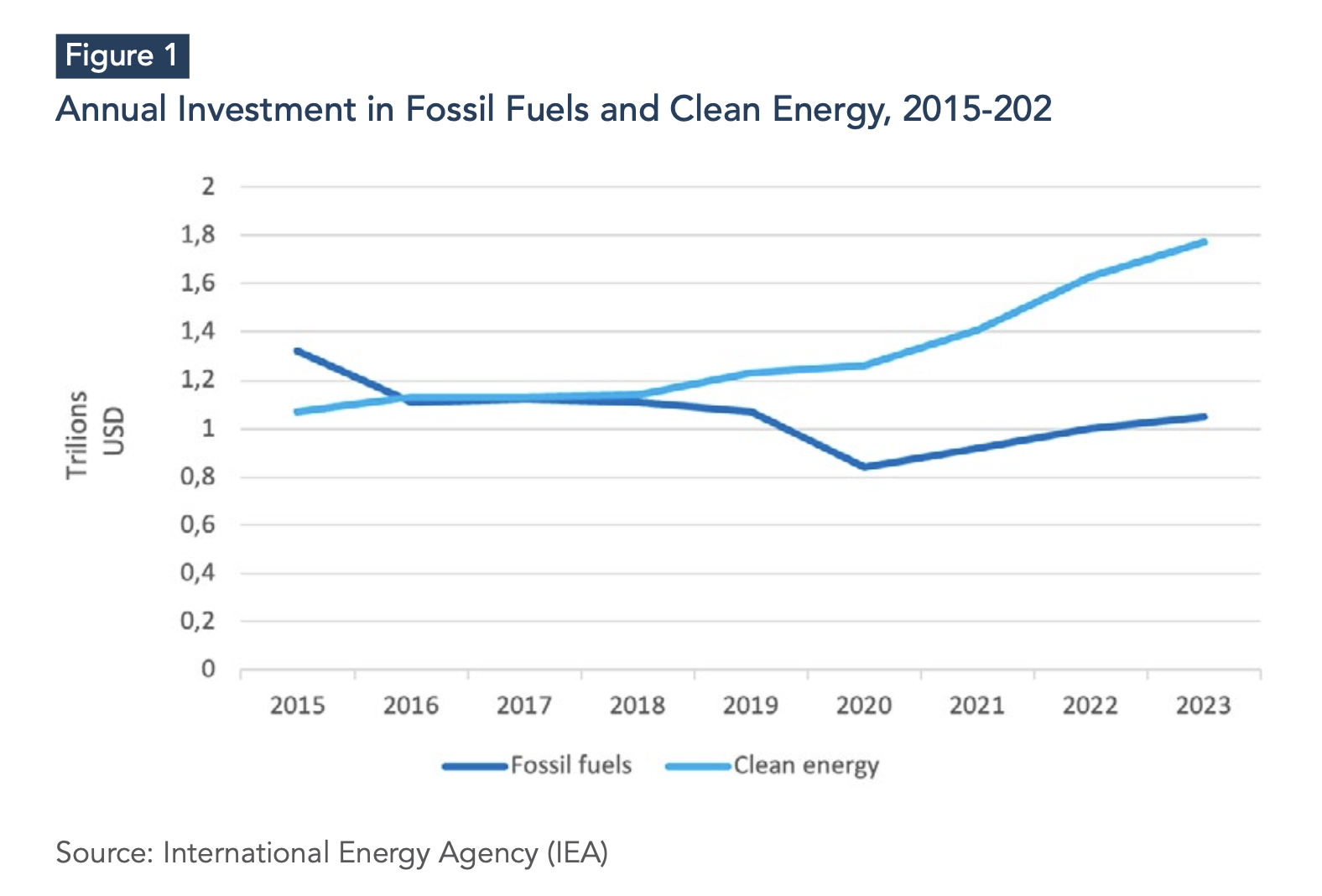
According to the latest report from the International Renewable Energy Agency (IRENA), by the end of 2023, renewable energy accounted for 43% of the world's installed power capacity. That year saw the most substantial increase in renewable energy capacity, with nearly 473 gigawatts (GW) added. Renewable energy reached a record 86% of new electricity generation capacities, largely due to the significant growth in solar and wind energy.
The availability of competitive renewable resources promises a diversification of energy supply and a reconfiguration of global trends.
Countries that are dependent on fossil fuel imports but have solar or wind resources can transform from net importers to producers, or even exporters, while enhancing their energy security. New sectors associated with renewable energy can be developed, opening new opportunities for growth and economic development in emerging green industries (e.g., green hydrogen, green ammonia). However, this transition could also lead to job losses, particularly in countries whose economies are heavily reliant on fossil fuels for revenue or employment.
At the 2023 United Nations Climate Change Conference (COP28) held in Dubai, nations agreed on the need to accelerate the energy transition; They explicitly affirmed the goal of gradually phasing out fossil fuels from energy systems in a just, orderly, and equitable manner, tripling renewable energy production capacities, and double energy efficiency programs by 2030.
Indeed, fossil fuel production and consumption account for 86% of global carbon dioxide (CO2) emissions, with 37% coming from coal, 29% from oil, and 20% from gas. Notably, due to its lower emission levels compared to other fossil fuels, natural gas is considered, like nuclear energy, a transitional fuel that can play a key role in facilitating the energy transition while ensuring energy security.
For African countries, the shift from fossil fuels to clean energy raises several questions regarding the deployment process and the impact of this transition on development dynamics across the continent.
These countries face structural challenges such as ensuring widespread access to affordable energy, modernization and development of energy infrastructure, reduction of debt and risk exposure, as well as strengthening institutions and governance bodies. Their energy transition largely depends on their specific socio-economic context. The global goals to reduce or even eliminate the use of coal and oil seem unattainable given the persistent difficulties faced by many African countries, particularly low-income ones, in improving their development indicators. Furthermore, these countries are often the most affected by the impacts of climate change, such as natural disasters or droughts, which could further exacerbate inequalities and increase their vulnerabilities.
According to a 2023 report by the United Nations Environment Programme (UNEP) on emission gaps, the increased energy consumption required for the poorest countries to achieve development goals would have a limited impact on greenhouse gas emissions. Indeed, the energy needed to provide basic services, such as food, healthcare, education, thermal comfort, and mobility, would range from 12 to 40 gigajoules per capita, depending onclimate, geography, economic structure, and culture. This level remains well below the global average energy consumption of approximately 75.7 gigajoules per capita.
Thus, implementing energy transition strategies in Africa raises genuine questions about social justice and the right to development, while also presenting new opportunities for a continent seeking to stimulate its economic growth and meet the aspirations of its people. The concept of a just transition has evolved over the past decade and offers a compelling framework for addressing the energy transition with a broader perspective, emphasizing social aspects and inclusion.
Evolution of the Just Transition Concept
Although the Paris Climate Agreement does not explicitly mention the concept of a just transition, several principles within the agreement underscore the importance of supporting developing and vulnerable countries in alignment with their national goals, emphasizing international cooperation. The preamble of the agreement highlights "the imperative of a just transition of the workforce and the creation of decent work and quality jobs, in accordance with nationally defined development priorities."
Since 2015, the call for a just transition has gained prominence on the international agenda. Notably, the guiding principles published by the International Labour Organization (ILO) in 2015 established a broader understanding of a just transition, describing it as: "greening the economy in a way that is as fair and inclusive as possible to everyone concerned, creating decent work opportunities and leaving no one behind."
The first formal declaration on a just transition was made at COP24 in 2018, known as the "Silesia Declaration," which was adopted by 53 signatories. This declaration emphasizes the creation of decent jobs, principles of inclusion, support for developing countries, and protection of workers' interests during the transition process. It supports the shift towards climate-resilient, low-greenhouse-gas-emission development, aligned with the United Nations Sustainable Development Goals (SDGs).
In its sixth assessment report published in 2022, the Intergovernmental Panel on Climate Change (IPCC) defined 11 elements of a just transition. These include investing in low- emission technologies and sectors, promoting social dialogue and democratic consultation with social partners and stakeholders, and addressing intergenerational justice concerns, such as the impacts of policy decisions on future generations.
Meanwhile, Multilateral Development Banks (MDBs) have committed to supporting a just transition that promotes economic diversification and inclusion. In 2021, they published "High-Level Principles" that outline, among other things, the goals, processes, and expected outcomes of this transition.
One of the outcomes of COP27 was the establishment of a dedicated "Just Transition" work program, an initiative that continued into COP28. This program is designed to promote sustainable development, eradicate poverty, and create decent and quality jobs. Key principles adopted include fostering international cooperation, directing financing suited to the needs of climate-resilient and low-carbon development, and facilitating the deployment and transfer of technologies.
In line with this, the first high-level annual ministerial roundtable on a just transition was held on December 3, 2023, alongside COP28. Its purpose was to provide guidance and recommendations for this work program, exploring various potential pathways for transformation.
As a result, there is no fixed definition or singular interpretation of the concept of a just transition, which has evolved over the past decade. However, two main dimensions seem to emerge. The first is related to climate justice and the principle of common but differentiated responsibilities, as established in the Paris Agreement. This implies that developed countries should support less advanced countries in their efforts to mitigate the negative impacts of climate change and reduce their carbon emissions. The second dimension concerns the strategies and action plans adopted by each country, which must be fair, inclusive, and equitable.
The concept of a just energy transition, has been emphasized through the Just Energy Transition Partnerships (JETPs) launched in 2021, which aim to mobilize finance from developed countries to support emerging economies. Originally conceived outside the UN climate negotiations by the G7 forum of major economies, JETPs seek to accelerate the decarbonization of the energy sector in countries heavily reliant on fossil fuels, particularly coal.
Across the African continent, South Africa has signed a Just Energy Transition Partnership (JETP) valued at $8.5 billion. However, the financing mobilized, primarily in the form of loans, remains insufficient compared to the actual needs, which are estimated to exceed $95 billion.
In 2023, another partnership was announced with Senegal, amounting to approximately $2.7 billion. This initiative aims to integrate renewable energy into the country’s energy mix and support the conversion of gas into electricity. This development comes as financial contributors, particularly European countries, seek to diversify their gas supplies following the conflict between Ukraine and Russia.
Despite nearly a decade of awareness regarding the need for a just transition in developing countries, international cooperation mechanisms remain highly limited and ineffective.
Existing cooperative actions are often focused on specific sectors, primarily energy, or targeted at particular stakeholders, notably workers dependent on fossil fuel industries. This relatively narrow approach does not fully account for the broader socio-economic impacts of the transition, which potentially perpetuating existing vulnerabilities and limiting opportunities for new growth.
Other similar initiatives and collaboration frameworks, such as those from the United Nations Development Programme (UNDP), IRENA, and the International Energy Agency (IEA), mainly focus on guidelines, studies, or support measures.
Non-governmental organizations have increasingly mobilized funds from donors to undertake actions. However, their scope is often limited and does not fully address the diverse and numerous needs.
The effectiveness and relevance of such programs and initiatives depend on their adaptation to specific contexts and the resources allocated. Challenges observed in implementing similar programs, such as those for climate change adaptation in Africa, highlight obstacles encountered and the failure to meet promises regarding mobilization of funding from developed countries and MDBs, despite the recognized urgency of their implementation.
A Just Energy Transition for Sustainable Development in Africa
Nearly 18% of the global population resides in Africa, yet, the continent accounts for less than 6% of global energy consumption and under 3% of CO2 emissions. The electrification rate in Africa is below 45%, with significant disparities between countries and between rural and urban areas. This rate also fluctuates due to the impact of droughts on hydropower production.
Stimulating economic growth, improving living conditions, and increasing resilience to climate change are major challenges that African countries must address to meet sustainable development goals.
Given that the continent’s heavy reliance on fossil fuels, the energy transition is both a necessity and an additional challenge that African countries must navigate successfully.

With population growth and urbanization, energy needs are expected to rise. However, energy poverty hinders the continent's development and is a key factor in the inadequate quality of public services, the lack of economic dynamism, and the low attractiveness of private investment in sectors such as industry, agriculture, and agribusiness.
In this context, the energy transition, aimed at reducing the carbon footprint, could create new opportunities for growth and development. This includes improving energy access and fostering the emergence of new green sectors where the continent has competitive advantages due to its natural resources.
Nevertheless, given Africa's political, economic, and social conditions, achieving such a transition is challenging. Its complexity lies in the difficulty of prioritizing energy transition projects in regions with significant disparities and vulnerabilities. With an extreme poverty rate of 35.5% across the continent, no transformation can be truly effective without addressing these deficiencies.
In fact, securing access to affordable energy, a major challenge for many African countries may be considered a lower priority compared to the adoption of low-carbon alternative energies.
Moreover, while the objectives of a just transition remain consistent whether a country is developed or not, the approaches to implementation differ significantly. Advanced countries primarily seek to minimize the negative impacts of their low-carbon policies, whereas less developed countries aim to derive new benefits from the transition.
These differences are also evident within the African continent. The energy transition strategies adopted by African countries vary according to their socio-economic development levels and their dependence on fossil fuels. For instance, South Africa is focusing in the short term on developing its oil and gas sectors to reduce its reliance on coal and pave the way for eventual decarbonization. In contrast, Morocco has been investing in renewable energy sector since 2009, with the goal of increasing the share of renewables to 52% in its electricity mix by 2030.
The energy transition is not merely about replacing one energy system with another. The synergies it can create such as improving access to water, enhancing food security, and strengthening industrial and logistical integration are levers that can directly contribute to the socio-economic development of a country.
The nexus between food security and energy security is particularly strategic on the continent. When effectively harnessed, this relationship can accelerate the reduction of gaps in key areas, including improving agricultural yield and productivity, and developing new crops in a sector that employs the majority of the African population.
A just energy transition can indeed support the achievement of several Sustainable Development Goals (SDGs) simultaneously. These include affordable and clean energy (SDG 7), gender equality (SDG 5), decent work and economic growth (SDG 8), reduced inequalities (SDG 10), responsible consumption and production (SDG 12), and climate action (SDG 13).
However, it is important to remember that the availability of energy resources alone is not enough to trigger real growth dynamics. Several African countries with significant energy resources, including fossil fuels that have been exploited for decades, have not managed to improve their SDGs at the desired pace. As they transition to new energy systems and adopt new or emerging technologies, the question remains : will they truly be able to creat positive transformations for their economies and the social conditions of their populations? A just transition for Africa, beyond the principles of inclusion and equity, must involve rapid progress toward development. It should integrate energy issues, development challenges, and climate concerns within the same framework.
This perspective necessitates aligning energy policies with development and climate change mitigation strategies. It also requires the adoption of specific approaches for managing the transformation process, identifying transition projects, designing them, financing them, deploying them, and selecting technological partners.
The export market for clean energy, particularly green molecules (e.g., green hydrogen, green ammonia, green methane), presents new growth opportunities for the continent. However, this potential depends on reducing the costs of electrolysis technology, developing large- scale industrial projects, and improving supply chain capabilities (storage, transportation, distribution, etc.). African countries' positioning will be determined by the segments of the value chain where they have competitive advantages, especially considering that most technologies are developed in China.
The African Development Bank (AfDB) indicates "The just transition framework facilitates equitable access to the benefits and distribution of the costs of sustainable development ensuring that the livelihoods of all people, particularly the most vulnerable, are supported and enhanced as societies move toward low-carbon, climate-resilient economies. A just transition affirms Africa’s right to development and industrialization, as captured in the Paris Agreement language on equity and common but differentiated responsibilities and respective capabilities, in light of differing national circumstances."
With well-designed policies, the benefits of the transition, such as reduced climate damage, could potentially outweigh the costs of climate mitigation by up to five times. However, poorly designed policies could have negative repercussions on economies, industries, and populations.
The Deployment of a Just Energy Transition Process in Africa
Thanks to favorable climatic conditions and the availability of critical minerals used in battery manufacturing, Africa holds significant potential in terms of natural resources to drive its energy transition. For instance, the continent boasts 60% of the world's solar capacity and nearly 70% of global cobalt reserves. Additionally, natural gas reserves, estimated at approximately 625 trillion cubic feet, are also expected to play a strategic role in this transition.
However, the mere availability of these resources and the growing demand for green energy are not sufficient to initiate a true low-carbon energy transformation across the continent. Most African countries are already close carbon neutrality. With a few exceptions, the energy transition represents primarily an opportunity for low-carbon development rather than an urgent necessity.
The effective utilization of natural resources in just energy transition programs largely depends on these countries' capacities in strategy design and implementation, infrastructure development, technological expertise, and financial mobilization.
These factors help explain why some Asian countries, despite facing economic challenges similar to those in Africa, have made notable progress in their just energy transition, particularly in terms of planning for mobilizing funding, as well us executing their programs. More developed infrastructure and a greater pool of skilled expertise have been advantageous factors.
Similarly, several Asian countries have successfully integrated clean cooking technologies into mainstream use. In contrast, some Sub-Saharan African countries are experiencing a rise in the number of people using unsustainable cooking methods, as demographic growth outpaces improvements in access to these technologies.
Public investment in infrastructure projects and public-private partnerships are crucial to support green energy initiatives, particularly in the transportation and storage of green molecules.
Moreover, simply replacing one industry with another is not the solution for a just energy transition. Instead, the focus should be on fostering diversification towards a more sustainable, resilient, and inclusive economy. Building this new economy requires substantial operational capacities from both public and private sectors.
The complexity of projects and the rapid technological evolution in green energy sectors (e.g., green hydrogen production and its derivatives, storage, distribution, carbon capture) necessitate tailored methods during both the design and the implementation phases. Well- planned phasing and the adoption of modular units provide the scalability, flexibility, and resilience required for investment programs.
This gradual process facilitates the integration of technological advancements and allows for the adjustment of production capacities based on demand, ensuring the viability and sustainability of investments.
Given the number of projects likely to be initiated over the next decade as part of Africa's energy transition, investing in the development of African expertise and specialized research centers is highly justified.
The creation of dynamic databases on solar radiation, wind speeds, climate, water, and soil characteristics can consolidate strategic information and support decision-making, aiding transition policies while maintaining the energy-food security nexus.
The rapid technological evolution in green sectors also requires greater local ownership by African countries to drive these changes effectively. Additionaly, the exploitation of critical minerals, a key issue, should be conducted locally, leveraging competent industries and research centers.
On the other hand, innovation driven by local solutions presents a promising opportunity for African countries. It addresses specific needs by considering local realities and encourages African research to focus on continent-specific issues.
A notable example is an African fintech platform leveraging the power of digital micropayments and the Internet of Things to enable its clients to acquire productive assets. Active in Kenya, Nigeria, Ghana, and South Africa, this platform offers solar equipment, electric motorcycles, microloans, and microinsurance. This model allows over 630,000 households to switch to clean, renewable energy without needing access to the traditional electrical grid. By making a $35 deposit, clients receive a solar energy system activated by GSM technology and pay $0.45 daily.
Small-scale, decentralized clean energy production systems, often equipped with smart mechanisms, provide an effective way to deliver clean technology to dispersed households without grid access. These systems also create local jobs and maintenance services. However, such solutions are complementary and cannot fully replace large-scale, centralized systems which offer better cost optimization and reliable supply continuity.
It is crucial to prioritize projects that, beyond their intrinsic value, contribute to their ecosystem—particularly in terms of job creation, technological transfer, and local industrial integration. The sustainable management of resources such as water, land, forests, and minerals, along with investment in the circular economy, should be integral to any new energy sector investment.
The orchestration of various stakeholders’ roles is fundamental for the success of a just energy transition. Public initiatives, supported by private sector engagement and civil society involvement, offer significant advantages. Inclusion, a core principle of a just transition, emphasizes the involvement and consultation of all stakeholders throughout the transition process, particularly the most vulnerable, including youth and women, to address gaps and disparities.
Platforms for dialogue, exchange, and consultation can stimulate action, facilitate the adoption and implementation of proactive energy strategies, and contribute to the development of effective policies that support large-scale investments.
However, achieving the goals of a just energy transition across the continent would be difficult without external financial assistance. This gap could exacerbate existing disparities in sustainable development and climate change mitigation.
The high exposure of African states to financial and economic risks, combined with their debt burden, represents significant obstacles. These structural constraints limit their ability to attract private investment and to implement effectively their development and just transition policies.
Specialized funds already exist, such as the Sustainable Energy Fund for Africa (SEFA) managed by the African Development Bank (AfDB), which provides catalytic financing to unlock private sector investments in renewable energy and energy efficiency.
Most recently, in April 2024, the World Bank Group announced its commitment to connect 250 million Africans to electricity by 2030 through decentralized renewable energy systems or distribution networks. The African Development Bank Group will support an additional 50 million people.
However, additional efforts are needed to accelerate progress, relying on innovative financial instruments tailored to the African context. The goal is to avoid overburdening countries with debt while considering the medium and long-term impacts.
It must also be recognized that, beyond the aforementioned constraints, the low level of integration across the continent represents a structural barrier to the deployment of large-scale transformation strategies. The African Union’s Agenda 2063 emphasizes the importance of integration, as a key driver for the continent's economic and social development.
Although initiatives, like the African Continental Free Trade Area (AfCFTA) and regional transport corridors have been launched, the benefits of these initiatives remain dependent on expanding integration into other sectors, such as energy.
Strengthening integrated regional electricity networks and developing regional trade in green electricity across the continent, would significantly reduce the average cost of electricity on the continent. In this regard, several projects have been initiated, such as the West African Power Pool, involving 14 countries, and the Eastern Africa Power Pool, involving 9 countries. These electrical interconnection projects, despite the constraints that have delayed their implementation, offer valuable experiences and important lessons to guide future projects with the required efficiency.
Often, the geopolitical context, exacerbated by regional tensions or conflicts, is the root cause of the lack of integration. This unfavorable situation limits the benefits of complementarities between neighboring countries, and the opportunities offered by cross-border interconnection projects.
The initiative launched on November 6, 2023, by His Majesty King Mohammed VI on the occasion of the 48th anniversary of the Green March, for the development of the Afro- Atlantic façade, represents a strategic dynamic for continental integration. It reinforces African initiatives by providing an additional, and pivotal lever through its multidimensional and multisectoral approach.
This initiative combines infrastructure development, particularly in logistics and port facilities, with energy integration particularly through the Morocco-Nigeria gas pipeline project, and the promotion of several high-potential productive sectors.
Given the vastness of this geographical area and its abundant natural resources, this initiative presents a high potential for catalytic transformative effects, impacting not only the 23 countries along the Atlantic façade, but also the Sahel countries.
Considering the numerous constraints and challenges faced by the continent, the efforts of African countries, multilateral development banks, and investment funds should be more focused on structural projects that foster synergies among different countries and can generate wider impact.
The challenges of a just energy transition are not limited to individual countries; their effects extend across-borders.
The global movement towards a just transition requires a high level of strong international cooperation with appropriate financing mechanisms.
African-led pathways are essential to initiate a genuine transformation dynamic, addressing energy issues, development challenges, and climate change mitigation.
Bibliography
- IRENA (2021). Perspectives pour les transitions énergétiques mondiales : Trajectoire vers l’objectif de 1.5°C. Agence internationale pour les énergies renouvelables, Abu Dhabi.
- IRENA (2024). Renewable Capacity Statistics 2024. International Renewable Energy Agency, Abu Dhabi.
- PNUD (2022). Comment faire contribuer la transition juste à la réalisation de l’Accord de Paris.
- United Nations Environment Program (2023). Emissions Gap Report 2023: Broken Record – Temperatures Hit New Highs, Yet World Fails to Cut Emissions (Again). Nairobi. https:// doi.org/10.59117/20.500.11822/43922
- OXFAM (2022). Pour une transition juste. December 2022.
- UNFCCC (2023). L’accord de la COP28 marque le début de la fin de l’ère des combustibles fossiles.
- UNFCCC (2023). Programme de travail de la transition juste. https://unfccc.int/sites/default/ files/resource/cma2023_L14F.pdf
- GIEC (2022). Sixième rapport d’évaluation, Changements climatiques 2022 : atténuation des changements climatiques (Groupe de travail III).
- Birol, F. (2022). L’Afrique a le plus à gagner de la transition vers des énergies propres. Groupe d’études géopolitiques.
- Connaissances des Énergies (2022). La situation énergétique de l’Afrique en infographies. June 2022. https://www.connaissancedesenergies.org/la-situation-energetique-de- lafrique-en-infographies-240320
- AfDB (2022). Just Transition Initiative to Address Climate Change in the African Context. (Accessed July 24, 2022).
- African Development Bank Group (2023). A Just Transition to Address Climate Change in the African Context.
- IEA (2023). Annual Investment in Fossil Fuels and Clean Energy (2015-2023).
- Imdadullah, Alamri, B., Hossain, M.A., & Asghar, M.S.J. (2021). Electric Power Network Interconnection: A Review on Current Status, Future Prospects, and Research Directions. Electronics, 10(21), 2179. https://doi.org/10.3390/electronics10172179
- ADB (2023). Asian Development Outlook 2023, Thematic Report. April 2023. https://www. adb.org/sites/default/files/publication/876891/ado-2023-thematic-report.pdf
- Kimura, S. (2023). Energy Outlook and Energy-Saving Potential in East Asia. Economic Research Institute for ASEAN and East Asia (ERIA).

